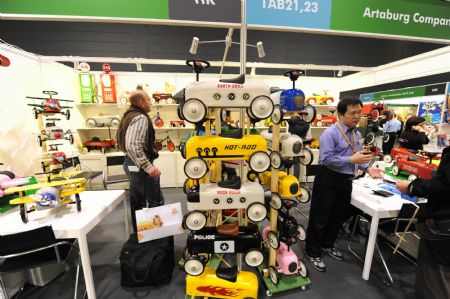Brazil sets conditions on China's toy story
|
|
|
Toys are displayed at a pavilion in south China's Hong Kong. The value of China's exports of toys and parts grew by 30.3 percent to $9.34 billion during the first 11 months of this year, only 3 percent of which went to Brazil. |
Amid the backdrop of the rising Brazilian currency, the real, against the yuan, Brazil increased tariffs on toy imports from China by 15 percent on Wednesday.
It's the third time in eight days that the South American nation has launched a trade-remedy case against Chinese imports.
The measure aims to help Brazilian toy manufacturers gain a competitive edge, as China accounts for as much as 90 percent of the nation's total toy imports. However, the move will not hurt Chinese manufacturers too badly, as the industry's export volume to Brazil is still small, said experts.
According to the Brazilian Foreign Trade Chamber, the South American country has raised duties from 20 percent to 35 percent on 14 types of toys including dolls, puzzles, tricycles and electric trains.
The tariffs will be effective by the end of 2011.
The move comes in response to a request from Brazilian toymakers for help in fending off the fierce competition posed by the influx of Chinese imports.
The tariff increase is the third time Brazil has initiated a trade-remedy case against China during the past eight days.
According to the Chinese Ministry of Commerce, Brazil announced it started anti-dumping investigations into imports of Chinese seamless steel pipes on Dec 22, and non-stainless steel household vessels on Dec 24.
Meanwhile, on Dec 21, the Brazilian Citric Acid Industry Association applied to its government to launch an investigation into Chinese imports of the acid.
"It is an unavoidable trend that Brazil is launching more trade-remedy cases against China, as they are competing at the same level in many sectors. China must be fully prepared for that," said He Weiwen, a council member of the China Society for World Trade Organization Studies.
China supplies more than 90 percent of Brazil's toy imports, and figures from the Ministry of Trade of Brazil show that they totaled imported toys worth $290 million between January and November.
But Brazil is still a small market for Chinese exporters. According to China's General Administration of Customs, the value of China's exports of toys and parts grew by 30.3 percent to $9.34 billion during the first 11 months of this year, only 3 percent of which went to Brazil.
The United States and European Union are China's top two export markets for toys, buying about 60 percent of the total output from Chinese factories. This year, the emerging markets of the Association of Southeast Asian Nations (ASEAN) rose to the fifth-largest export market for China, replacing Canada.
As the developed nations established more trade barriers for imports of toys and demand shrinks, Chinese toy makers have started to cast their eyes on the emerging markets, including Brazil, Russia and ASEAN.
According to a study published this month by Brazil's State Development Bank, imports of Chinese goods in the 12 months through August increased 37 percent to $21.4 billion, from $15 billion in the whole of 2009.
In August, the Brazilian government began to reduce import tariffs on toy parts and raw materials from 20 percent to 2 percent, in a bid to enhance the competitiveness of its domestic producers.
It is estimated toy sales in Brazil will reach $1.8 billion this year, 49 percent of which will come from products made abroad.
 0
0 








Go to Forum >>0 Comments